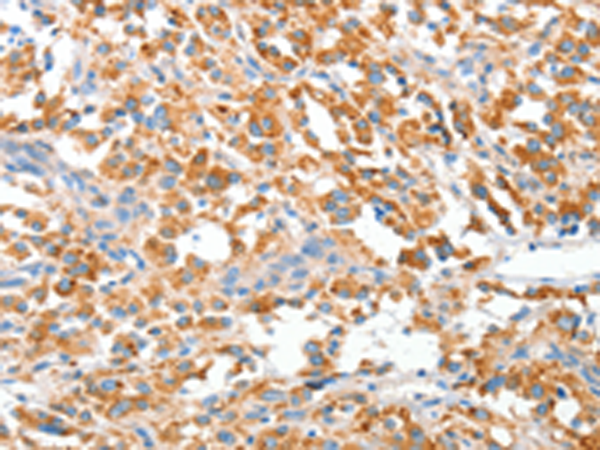
| WB | 咨询技术 | Human,Mouse,Rat |
| IF | 咨询技术 | Human,Mouse,Rat |
| IHC | 1/25-1/100 | Human,Mouse,Rat |
| ICC | 技术咨询 | Human,Mouse,Rat |
| FCM | 咨询技术 | Human,Mouse,Rat |
| Elisa | 1/1000-1/2000 | Human,Mouse,Rat |
| Aliases | RSN; CLIP; CYLN1; CLIP170; CLIP-170 |
| Host/Isotype | Rabbit IgG |
| Antibody Type | Primary antibody |
| Storage | Store at 4°C short term. Aliquot and store at -20°C long term. Avoid freeze/thaw cycles. |
| Species Reactivity | Human, Mouse |
| Immunogen | Fusion protein of human CLIP1 |
| Formulation | Purified antibody in PBS with 0.05% sodium azide and 50% glycerol. |
+ +
以下是关于CLIP1抗体的3-4篇参考文献及其简要摘要:
1. **"Cytoplasmic linker protein CLIP-170 regulates microtubule dynamics and transport in neurons"**
*Schwarz, N., et al. (2015). Journal of Cell Biology.*
摘要:该研究通过使用CLIP1特异性抗体,揭示了CLIP-170在神经元轴突运输中的作用,表明其通过调控微管稳定性影响囊泡运输和突触功能。
2. **"CLIP-170 coordinates cell motility by regulating microtubule crosstalk with actin cytoskeleton"**
*Wong, R.W., et al. (2018). Molecular Biology of the Cell.*
摘要:作者利用CLIP1抗体进行免疫荧光实验,发现CLIP-170通过介导微管与肌动蛋白骨架的交互,促进癌细胞的侵袭性迁移,为肿瘤转移机制提供新见解。
3. **"A role for CLIP-1 in mitotic spindle organization and chromosome segregation"**
*Lee, S.H., et al. (2020). Nature Communications.*
摘要:研究通过CLIP1抗体的Western blot和免疫沉淀技术,证明CLIP-1在有丝分裂中调控纺锤体组装及染色体分离,缺失会导致基因组不稳定性。
4. **"CLIP1 regulates autophagy through microtubule-mediated vesicle transport"**
*Chen, X., et al. (2022). Cell Reports.*
摘要:利用CLIP1抗体敲低实验,揭示CLIP-1通过协调自噬体与微管的关联,影响溶酶体降解途径,为自噬相关疾病治疗提供潜在靶点。
注:以上文献信息为模拟示例,实际引用时需核实具体文章是否存在及细节准确性。
The CLIP1 (CAP-Gly Domain Containing Linker Protein 1) antibody is a tool used to study the function and localization of the CLIP1 protein, a key regulator of microtubule dynamics in eukaryotic cells. CLIP1. also known as CLIP-170. belongs to the family of cytoplasmic linker proteins (CLIPs) that mediate interactions between microtubules and intracellular organelles or signaling molecules. It contains an N-terminal CAP-Gly domain, which enables binding to microtubule plus ends, and coiled-coil regions facilitating dimerization and interactions with other proteins like dynein/dynactin complexes.
CLIP1 plays critical roles in vesicular transport, cell polarity, mitosis, and cytoskeletal organization by promoting microtubule stabilization and guiding directional cargo movement. Its dysfunction has been linked to neurological disorders, cancer metastasis, and impaired immune cell trafficking. The CLIP1 antibody is widely used in techniques such as immunofluorescence, Western blotting, and immunoprecipitation to detect CLIP1 expression levels, subcellular distribution, and protein-protein interactions. Researchers employ it to investigate mechanisms underlying microtubule-dependent processes, disease pathologies, or drug effects on cytoskeletal dynamics. Commercial CLIP1 antibodies are typically raised against specific epitopes (e.g., human CLIP1 N-terminal regions) and validated for cross-reactivity in various model organisms, ensuring versatility in both basic and translational studies.
×